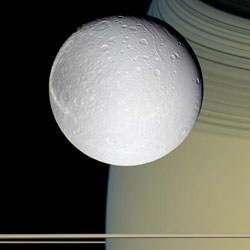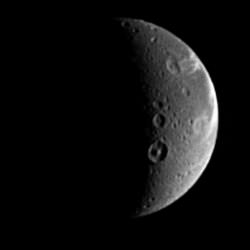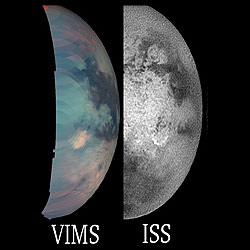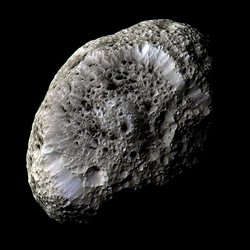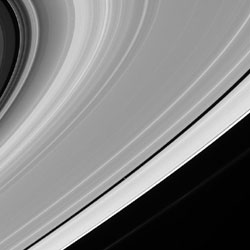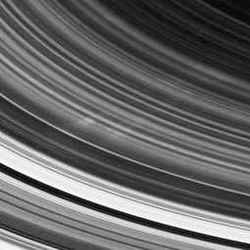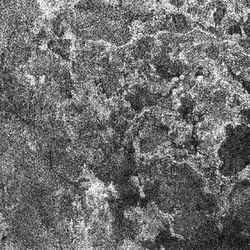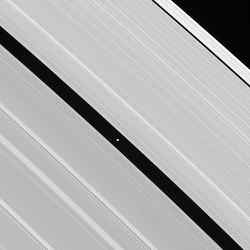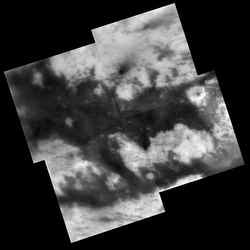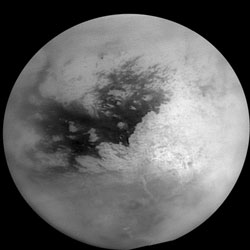
Saturn’s Moon Titan. Image credit: NASA/JPL/SSI. Click to enlarge.
University of Arizona scientists say that the peculiar clouds at middle latitudes in Titan’s southern hemisphere may form in the same way as distinct bands of clouds form at Earth’s equator.
“Titan’s weather is very different from Earth’s,” said UA associate professor Caitlin Griffith. “If you walked past Titan’s minus-40-degree-latitude line, you might be showered with liquid natural gas. If you decided to visit Titan’s south pole, you might encounter a storm the size of a hurricane which also consists of methane, more commonly known as natural gas,” Griffith said. “Otherwise, don’t expect clouds on Titan.”
Titan’s weather forecast has remained the same for years, and that baffles scientists. They don’t understand why clouds a thousand miles long stretch over the temperate latitude.
“Imagine how curious it would be if beyond Earth’s poles, clouds existed only at the latitude that crosses New Zealand, Argentina and Chile,” Griffith said. “Furthermore, Henry Roe (of the California Institute of Technology) and his colleagues find that most of these peculiar clouds bunch up at zero degrees and 90 degrees longitude, analogous to Earth longitudes southwest and southeast of the Cape of Good Hope,” she added.
The highly localized nature of the clouds suggests that they have something to do with Titan’s surface, Griffith said. Scientists think ice volcanoes must be venting methane — the gas that condenses as clouds — into Titan’s hazy, mostly nitrogen atmosphere. Otherwise, the moon’s atmospheric methane would have vanished billions of years ago because methane is destroyed by ultraviolet sunlight.
Griffith, Paulo Penteado and Robert Kursinski of UA’s Lunar and Planetary Lab studied the origin of the clouds by analyzing cloud height and thickness using images from Cassini’s visual and infrared mapping spectrometer (VIMS). This instrument is among a suite of instruments on the Cassini spacecraft orbiting Saturn. It measures light at 256 different wavelenghts. Griffith is a member of the UA-based VIMS team, headed by Robert Brown of UA’s Lunar and Planetary Lab. Griffith and her colleagues analyzed images that gave them a 3-D view of the cloud and a six-frame movie that shows how it evolved over three hours.
“The structure of the clouds turns out to be complicated,” Griffith said. “We detected not one region, but many regions of cloud formation. Each long cloud consists of a number of vigorous storms where clouds rise to 40 kilometers altitude (25 miles) in a couple of hours and dissipate in the next half hour. The rate of cloud ascent and dissipation suggests that we are witnessing the formation of convective clouds, likely similar to thunderstorms, that disappear through rainfall.
“Over the next several hours we see the clouds form long tails, indicating that strong westerly winds stretch out the clouds and carry the particles downwind a thousand kilometers (more than 600 miles). This detailed look into the structure of these clouds reveals that the clouds evolve from a number of small active cloud formation centers lined up like an uneven string of beads long 40 degrees south latitude. These localized storms cause a healthy rain, and very long clouds, once the wind has stretched them out.”
Griffith argues that it’s improbable that many ice volcanoes, all aligned at 40 degrees south latitude, are forming these clouds. In addition, the scientists estimate that the cloud activity at zero degrees longitude, if volcanic, does not appear to spew out enough methane to create the mid-latitude cloud band. Smaller clouds actually lie upwind of the main cloud at zero degrees longitude, they note. The team also conclude that the clouds aren’t obviously caused by Saturn’s tidal pull on Titan’s atmosphere. They also don’t find evidence that mountains and lakes might cause mountain clouds or marine clouds, Griffith said.
“We believe that it’s no coincidence that Titan’s south polar cap of smog extends from the pole to 40 degrees south latitude — exactly where the methane cloud band appears,” Griffith said. The researchers suggest that global circulation may cause the air to rise at this latitutude on Titan, much as clouds form in a band around the Earth’s equator and rain on the Caribbean islands. “Such rising air would cut off air from the south polar region from mixing with the rest of the moon’s atmosphere, causing smog to build up and form a cap over the pole,” Griffith added.
Theoretical modeling supports the UA team’s conclusion, Griffith said. Pascal Ranou and his group in Paris studied Titan’s circulation with an elaborate and complicated general circulation model. His model predicts that solar heating naturally creates rising air on Titan at 40 degrees south latitude.
The next mystery is why Titan’s southern mid-latitude clouds are bunched at zero degrees longitude. There’s no evidence yet that volcanoes, mountain ranges or Saturn’s tides are involved, Griffith said. “What’s causing the bunching is unclear, and likely involves unknown features on Titan’s still largely unexplored surface,” Griffith said.
Griffith, Kursinki and Penteado are publishing an article on their research in the Oct. 21 issue of Science.
The Cassini-Huygens mission is a cooperative project of NASA, the European Space Agency and the Italian Space Agency. The Jet Propulsion Laboratory, a division of the California Institute of Technology in Pasadena, Calif., manages the mission for NASA’s Science Mission Directorate, Washington, D.C. The Cassini orbiter and its two onboard cameras were designed, developed and assembled at JPL. The Visual and Infrared Mapping Spectrometer team is based at The University of Arizona in Tucson.
Original Source: University of Arizona News Release

